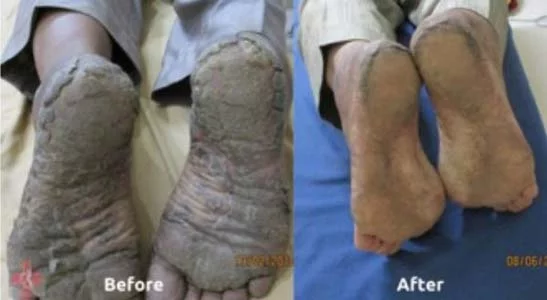Psoriasis is a habitual (long-lasting) skin disease which is characterized by patches of abnormal skin that cause skin cells to grow too quickly, resulting in thick, white, silvery, or red patches of skin.
The Psoriasis most frequently appear on the knees, elbows, scalps, hands, feet, or lower reverses. They may vary in inflexibility from small and localized to complete body coverage.
This is the most common skin disorder or problem which usually affecting about 2% of the population and most common for adults. But in some cases children and teens can also get it too. Having psoriasis can be embarrassing, disturbing and most of the people, especially teens, avoid swimming and some works or activities which they like to do but avoid those thinks due to psoriasis other in some situations where patches can show.
Know a days there are so many types of Psoriasis treatments are there that can help to keep psoriasis under control.
Psoriasis is non-contagious; disease thereby it can’t be spread easily by touching from person to person.
We at Clear Skin Centre have so many treatments for controlling of Psoriasis
The exact cause of psoriasis is not clear.
Genetic or Hereditary: Genetically inherited, because certain genes are found in families who are affected by psoriasis. About 1/3 rd of people who have psoriasis has one or more family members with the condition.
Immunological: Immune system disorder that causes the skin to regenerate at faster than normal rates. This rapid turnover of cells results in scales and red patches
This is the surgical removal of the tattooed skin with primary closure or skin grafting; leaves a scar depending upon size removed.
Infection: Infections such as streptococcal infection of throat or skin infections can cause psoriasis to appear suddenly, especially in children.
Weather conditions: Cold and dry climate can trigger flares of psoriasis. Usually, sunlight improves the condition, though occasionally, it may make it worse.
Sunlight exposure-intense exposure to the sun can worsen psoriasis.
Skin injuries: An injury to the skin can cause psoriasis patches to form anywhere on the body, including the site of the injury. This includes injuries to your nails or nearby skin while trimming your nails.
Emotional or physical stress: Stress may cause psoriasis to appear suddenly or make symptoms worse.Smoking may likely to worsen psoriasis.
Alcohol: A high alcohol intake can cause symptoms to flare-up. Alcohol consumption may decrease the effectiveness of some psoriasis treatments.
Certain medications: such as non-steroidal anti-inflammatory drugs (NSAIDs), high blood pressure (beta-blockers) medications, anti-malarial drugs, and lithium, have found to aggravate psoriasis. Rapid withdrawal of oral or systemic corticosteroids
Mild Psoriasis the rash may be asymptomatic with small areas red scaly patches.Moderate to severe cases, the skin gets inflamed with raised red areas topped with loose, silvery, scaling skin. If psoriasis is severe, the skin becomes itchy and tender. And sometimes large patches form and may be uncomfortable. The patches can join together and cover large areas of skin, such as the entire back.
It can also affect the finger nails and toe nails, causing the nails to pit, change color, and separate from the nail bed. Dead skin may build up under the nails. After a quite long period in some people, psoriasis causes joints to become swollen, tender, and painful. This is called psoriatic arthritis
The most common form of psoriasis, that affects almost 80% cases among psoriasis and also referred to as Psoriasis Vulgaris. It appears as well-defined areas of raised red skin that have flaky, silvery-white scales on the top build-up by dead skin cells.
The scale loosens and sheds regularly. These lesions are itchy and usually occur on the scalp, elbows, knees, and lower back.
This type is usually erupting after 2-3 weeks of sore throat triggered by a streptococcal bacterial infection. The lesions appear as drop-like or small pink patches with fine silver-white scales over the upper arms, thighs, and scalp of the individuals.
Inverse psoriasis: also called intertriginous psoriasis, appears as smooth, pure red lesions in a body skin fold, most commonly in the armpits, groin near the genitals, under the breasts, under the buttocks, or in abdominal folds. Sweat and rubbing together may irritate these inflamed areas.
The lesions appear as white pustules surrounded by red skin; though filled with pus but are non-infectious. The lesions initially appear as redness of the skin, followed by pustules and slight scaling. This condition is associated with constitutional symptoms like fever, chills, nausea, and muscular weakness.
It is a very rare form, appears as diffuse widespread bright red skin peeling away involving almost 70-80% of the body. It is accompanied by severe itching or burning sensation.
Nail psoriasis can cause discoloration or alteration in the nail bed, leading to separation of the nail from the nail bed. This results in small pits forming on your fingernails or toenails. Moreover, in some cases, the chalky material is deposited under the nails
It is a variant of psoriasis that characteristically affects the palms of the hands and the soles of the feet. It appears as thickened red skin, pustules, or mixed features and can involve partially or entirely skin.
The skin involvement is accompanied by inflammation of the joints. Psoriatic arthritis usually involves the small joints of hands and foot. The condition presents as discoloration, stiffness, and pain over the joints or pipe-like swelling of the fingers and toes and joints.
Currently, there is no cure. However, Dermatologists and other researchers are continuously testing new drugs and treatments.The goal is to reduce inflammation and to control the shedding of the skin. The skin professional may suggest different types of treatment. Treatment is based on a patient’s health condition, age, lifestyle, and the severity of psoriasis.
There are plenty of topical applications available in the market, which on use avoid systemic side effects.
Light therapy is a first-line recommended treatment for moderate to severe psoriasis, either alone or in combination with other medications. It involves exposing the skin to controlled amounts of natural or artificial light. Multiple sessions of treatments are required for the desired results.
It is a handheld system that enables you to apply high, therapeutically-effective doses of monochromatic UVB light while leaving healthy skin unexposed and protected.
This medication is used for moderate to severe psoriasis or if other treatments haven’t worked. Due to potential side effects, some of these medications are used for only short periods and might be alternated with other treatments. Most of these drugs to be avoided during pregnancy or breastfeeding and or to be stopped 3 months prior to conception.
| DO | DON'T |
|---|---|
| Keep your skin moist | Do not scratch or scrub the lesions |
| Use an emollient or moisturizer | Do not smoke or drink alcohol |
| Use luke-water while bathing | Do not get emotional or physical stress |
| Pat your skin gently to dry | Do not get skin injured |
| Short expose to sunlight | Do not get expose to infection |
| Use broad-spectrum sunscreen | Do not forget to moisturize the skin |
| Use mild soap | Do not harsh soap |
| Do reduce the stress | Ignore small flare-ups |
| Do not expose to intense sun light |

